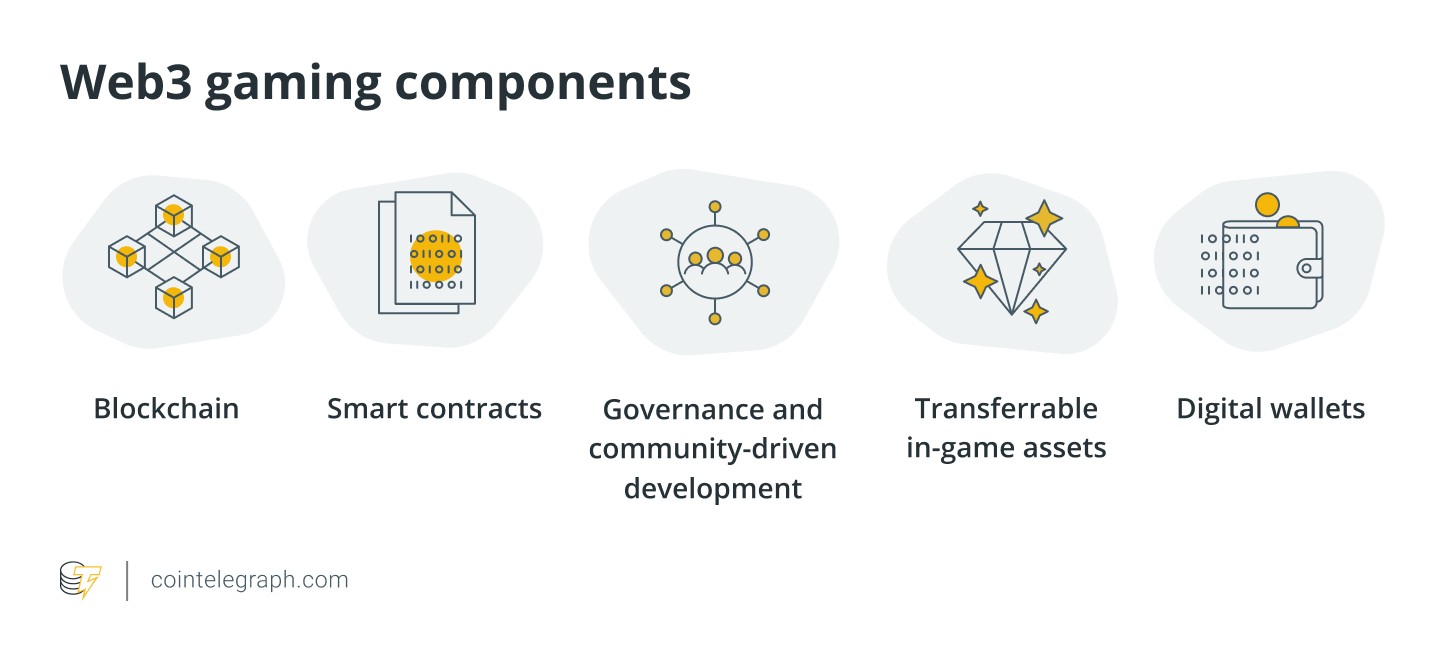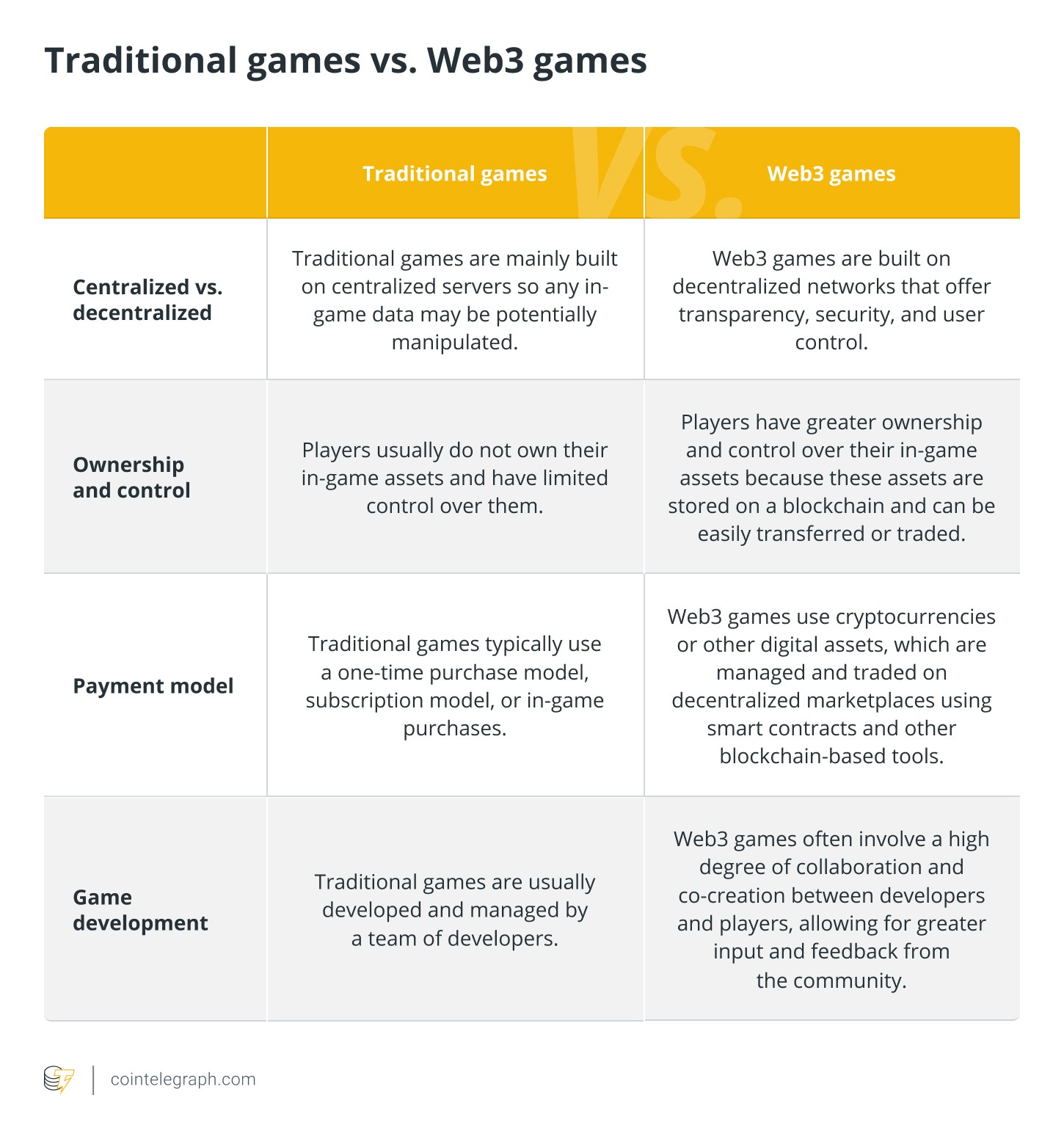What are Web3 games, and how do they work?

1.
What are Web3 games?
Web3-based gaming, also known as blockchain gaming, refers to gaming that utilizes distributed ledger technology to offer greater transparency, security, democratization and user control over in-game assets.
Web3 games are based on the decentralized, peer-to-peer architecture of blockchains, and include cryptocurrencies and nonfungible tokens (NFTs). Blockchain enables players to own and trade in-game items — like NFTs and other digital assets — and transfer them without third-party intervention. The assets are managed and traded on decentralized marketplaces using smart contracts.
Decentralization offers the gaming industry and players lots of unique benefits. Alongside the increased transparency and security a blockchain provides, decentralized gaming gave rise to the play-to-earn (P2E) gaming model, where players earn cryptocurrency for playing and leveling up in games.
Web3 gaming contributes to the gaming industry’s financial strength through innovations like decentralized autonomous organizations (DAOs), crypto-secured gaming wallets and the metaverse.
2.
How do Web3 games work?
Web3 games use blockchain technology to enable decentralized ownership of in-game assets and currencies, allowing players to earn, trade, and use these assets outside of the game. They also often incorporate cryptocurrency payments and smart contracts for secure and transparent transactions.
Web3 games are built on decentralized blockchains, allowing for greater transparency, security and user control compared with traditional centralized gaming platforms. Blockchain technology provides a tamper-proof ledger of all transactions and ensures that verifiable algorithms rather than centralized servers determine game outcomes.

Another key component of Web3 games is smart contracts, which are programmed to execute specific actions automatically when certain conditions are met, such as when a player buys or sells an asset. In Web3 gaming, they manage the ownership, transfer and trading of in-game assets.
Web3 gaming platforms utilize digital cryptocurrency wallets to house players’ in-game collectibles and assets. Crypto wallets are an important part of Web3 gaming architecture and a necessary tool for interaction with blockchain-based services.
Also, players can own and trade in-game assets, such as virtual items or currencies, which are stored on a blockchain and can be easily transferred or traded. NFTs or other digital assets often represent these assets.
Web3 games often involve high collaboration and co-creation between developers and players. The decentralized nature of the platforms allows for greater input and feedback from the community, which can help shape the game’s direction and evolution.
Gaming DAOs help create a player-driven gaming ecosystem to manage gaming communities and decentralized gaming platforms. Types of gaming DAOs include grant DAOs, gaming guilds, incubators and accelerators.
3.
Unique features of Web3 gaming
Web3 gaming offers several unique features like high transparency and greater control not possible on traditional centralized gaming platforms.
First, Web3 games provide high transparency since peer hosting ensures the players have all information, without a centralized third party limiting or hiding access. These games are effortlessly accessible to gamers. Buying cryptocurrency and setting up a wallet to start playing is simple, even for non-tech-savvy users.
Another important benefit of blockchain-based gaming is that it gives players greater ownership and control over their in-game assets, such as virtual land, currencies and characters. With Web3 technology, players can truly own and trade their digital assets — which can have real-world value — and exercise greater control over their gaming experience.
Web3 gaming creates innovative in-game economies where players are rewarded for gaming skills and simultaneously opens new monetization methods. For instance, in P2E games, players can generate income while playing and earn real money for their in-game achievements, like completing quests. This can create a more resilient and reliable ecosystem for players and developers.
Web3 gaming also ensures greater interoperability between different games and platforms. Players can use their assets in various contexts and settings, and easily transfer or trade them between different games.
Web3 game developers show how a new gaming ecosystem thrives on personalized player experiences, prioritizing immersive, engaging gaming processes with the best incentives for players. The P2E model is a big motivator for many gamers, and games are often designed with the player in mind.
Blockchain provides a way to track the provenance of digital assets. This means that developers and players can easily track the owners of specific assets and transaction history, resulting in greater transparency in the game’s economy.
Web3 gaming allows for digital scarcity, which means that in-game assets can be made unique, rare and valuable. In traditional gaming environments, this is tough to achieve. Developers can print more copies of rare items or give them to players as rewards, which can lead to inflation.
In Web3, game developers can ensure that in-game items are scarce and not subject to inflationary pressure. Items are stored on the blockchain and cannot be replicated or tampered with.

4.
Web3 games vs. Traditional games
Web3 games and traditional games have several key differences, including how they are built and played.
Here are some of the main differences between traditional and Web3 games:

5.
Risks of Web3 gaming
As attractive as the Web3 game space can be, it is still nascent and niche, with some significant challenges. There are issues associated with user adoption and mainstream acceptance.
Web3 can be complex, lacking user-friendly interfaces for non-crypto-savvy players. Developers, alongside the communities, should work to raise awareness and educate players about the advantages of Web3 games.
Web3 games are built on decentralized networks, which are generally more secure than centralized ones. However, Web3 games are still vulnerable to hacks and cyberattacks, which can lead to the loss or theft of game items. Gamers should take precautions to protect their private keys and use secure crypto wallets to store their digital assets.
Furthermore, there is a risk of missing something special — the “fun” element that is key to the overall gameplay experience. Web3 games may focus more on financial incentives than providing a fun and enjoyable experience. Web3 game developers must prioritize the fun gameplay element in design to attract a wider audience and compete with the major Web2 companies.
And last but not least, there is a regulatory risk since the legal and regulatory environment surrounding Web3 games is still evolving. There may be uncertainty around taxation, licensing and Anti-Money Laundering regulations. Developers and players should be aware of these risks and work to comply with the relevant rules.
6.
Examples of Web3 games
There are many blockchain games and decentralized applications (DApps) in the modern Web3 gaming universe like CryptoKitties, Axie Infinity, and Decentraland.
Each game has its unique features and game mechanics, but they all use the power of blockchain technology to create innovative gaming experiences not possible on traditional centralized gaming platforms.
Here are some examples of Web3 games:
- CryptoKitties is one of the first massively popular Ethereum-based games where players can collect, breed and trade unique digital cats. The game uses blockchain technology to ensure the uniqueness and ownership of each digital cat.
- Axie Infinity is a Pokemon-inspired play-to-earn metaverse game built on the Ethereum-linked Ronin sidechain developed by Sky Mavis, where players can collect, raise and battle creatures called Axies. Web3 tools allow players to own and trade their Axies and in-game assets.
- The Sandbox is a virtual world where players can build and monetize their virtual worlds, in-game assets and digital currencies using blockchain technology.
- Decentraland is a virtual world allowing players to create, explore and monetize their virtual experiences.
- Gods Unchained is a digital collectible card game that uses blockchain technology to allow players to own and trade their cards. The game uses the Ethereum blockchain to ensure the authenticity and scarcity of its digital cards.
7.
The future of Web3 gaming
The future of Web3 gaming is exciting and promising, as it offers new opportunities for players to truly own their in-game assets and currencies, as well as new revenue streams for developers.
Incorporating blockchain into gaming has changed the industry, democratizing it by removing centralized parties and creating new ways of monetization with more social and community-oriented gaming experiences — all of which further enhance the social and entertainment aspects of gaming.
However, it is unlikely that Web3 games will completely replace traditional games, as they offer different experiences and target different audiences. However, Web3 games have the potential to create new opportunities and revenue streams for the gaming industry and provide unique gameplay experiences.
Furthermore, as the technology and infrastructure for Web3 gaming continue to develop, we can expect to see more innovative and immersive games, increased adoption of cryptocurrency payments, and more opportunities for players and developers to participate in the decentralized gaming ecosystem.






 Bitcoin
Bitcoin  Ethereum
Ethereum  Tether
Tether  USDC
USDC  TRON
TRON  Dogecoin
Dogecoin  Cardano
Cardano  Bitcoin Cash
Bitcoin Cash  Chainlink
Chainlink  LEO Token
LEO Token  Stellar
Stellar  Monero
Monero  Litecoin
Litecoin  Hedera
Hedera  Zcash
Zcash  Dai
Dai  Cronos
Cronos  OKB
OKB  Tether Gold
Tether Gold  Ethereum Classic
Ethereum Classic  KuCoin
KuCoin  Gate
Gate  Algorand
Algorand  VeChain
VeChain  Cosmos Hub
Cosmos Hub  Dash
Dash  Stacks
Stacks  Tezos
Tezos  TrueUSD
TrueUSD  IOTA
IOTA  Basic Attention
Basic Attention  Decred
Decred  Theta Network
Theta Network  NEO
NEO  Synthetix
Synthetix  Qtum
Qtum  Ravencoin
Ravencoin  0x Protocol
0x Protocol  DigiByte
DigiByte  Nano
Nano  Zilliqa
Zilliqa  Siacoin
Siacoin  Holo
Holo  Numeraire
Numeraire  Waves
Waves  Ontology
Ontology  Status
Status  Enjin Coin
Enjin Coin  Pax Dollar
Pax Dollar  BUSD
BUSD  Hive
Hive  Lisk
Lisk  Steem
Steem  Huobi
Huobi  NEM
NEM  OMG Network
OMG Network  Augur
Augur  Bitcoin Gold
Bitcoin Gold  Ren
Ren  HUSD
HUSD